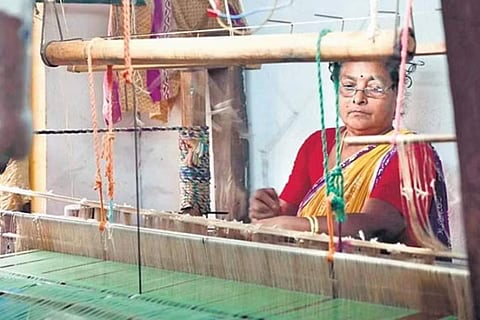
- LIFESTYLE
- FASHION
- FOOD
- ENTERTAINMENT
- EVENTS
- CULTURE
- VIDEOS
- WEB STORIES
- GALLERIES
- GADGETS
- CAR & BIKE
- SOCIETY
- TRAVEL
- NORTH EAST
- INDULGE CONNECT

In Venkatagiri, almost all houses have a loom. The equipment is what brings them income, food and glory from different parts of the world. Weaving isn’t an individual’s responsibility for residents here. Every member of every household contributes and works together to weave a sari. More than the colours, prints and designs of Venkatagiri saris, it is the culture of weaving that attracted T Dileep Rangan and his team at Big Short Films — Ramiz Naveeth (DOP), Ranjith B Krushna (AD), Parvay Balagopal (AD), Bhubanesh Raja (Editor), Anish Mohan (Music) — to make the documentary Soft Threads of Venkatagiri, released recently on YouTube.
Also Read: Two thought-provoking solo exhibitions in Mumbai this July
“Venkatagiri is not too far from Chennai. But the place has a huge difference when compared to the weavers of Kancheepuram which is still an extension of Chennai. Venkatagiri is least affected by the changes (developments) around the world. A lot of things aren’t still accessible to them. When one of the Venkatagiri weavers showed an interest in documenting their lives, we saw their work and understood their story and thus birthed the documentary,” shares Dileep.
The 13-minute-long film is produced by Vijaya Vauhini Charitable Foundation and Tata Trusts. The frames explore the lives of the weavers, the designs made in cotton and silk through Jamdani, Jala and Jacquard works. When Dileep’s last short film Kanchipuram Silk Motifs presented the viewers with the world of Kanchipuram saris through Krishnamoorthy, an award-winning third-generation weaver, Soft Threads of Venkatagiri focuses on the conflicts, challenges and hard work of the Venkatagiri weaving cluster and the efforts taken by the people to overcome their challenges.
Also Read: National Crafts Museum to start educational initiative on Indian Handlooms in Delhi this month
In 2006, there were about 10,000 looms in Venkatagiri. However, in 2023 there are only about 1,700 of them, comments the narrator in the documentary. “People think that Venkatagiri saris are doing very well. But, the business is not making progress as it did almost 40 years ago. The money they get is based on how much work they do. If a Venkatagiri weaver works for eight hours a day, they only make Rs 500. In a month they make only a maximum of Rs 5,000 to Rs 6,000. A lot of people have chosen other professions because of the financial restrictions,” says Dileep.
Addressing the issues
Unlike big cooperative societies, the looms and saris are restricted to houses. But the involvement of middlemen including textile owners or agents in the business adds to the already existing financial woes. Karunakar, a weaver from the Boppapuram village, Venkatagiri, in the documentary, admits that the pandemic threw the whole community into a dilemma. “March 2020, the pandemic hit the whole country and it caused us one of the biggest troubles. We couldn’t comprehend what was happening. We didn’t see a way to sell any saris, how we could make any money, it was all a mess,” he notes.
When people who aren’t aware of the legacy of the handloom choose to buy the cheap alternatives available in the market, that also puts the weavers into a recession. Vijay Kumar, a software engineer and a fifth-generation weaver says in the documentary, “Only 10% of the people have awareness of handlooms. Since people are unaware of the work and quality that goes into handlooms, they are not willing to pay the cost for the handlooms when a similar sari made on a machine is much cheaper.”
When the community was almost helpless Tata Trusts’ members reached out to them lending help. From providing awareness of the business, connecting them directly to the customer base to marketing and selling products on social media, the company continues to work for the empowerment of the weavers. “Tata Trusts has made a direct link between the customer and the weaver. They can call the weavers and place an order. This solves a lot of issues,” shares Dileep.
Also Read: Designer Susan Fernandes of Sustainable Suz presents a signature collection of ‘swathes’
Challenges in the making
Documenting the uniqueness of the textile in a place where the language is not your native language was a bit of a challenge, admits Dileep. He says, “In Venkatagiri, they spoke a different dialect of Telugu which was a bit difficult to understand but we tackled the issue with the help of translators.” Shooting in a location that was remote and not connected to the city, the crew also made adjustments to make the film in the limited facilities. It took the crew almost four-five months to complete the documentary.
The weavers of Venkatagiri claim that their technique of weaving is unique. Gowrabathini Ramaniah, a 73-year-old weaver says in the documentary, “Our technique doesn’t exist anywhere else in the world.” The processes from cutting a woven sari, folding it into its packaging, transporting it carefully so that it doesn’t crumple to handing it over to another weaver to sell it, is nothing less than an artwork. With their problems slowly getting addressed, the artisans are now working towards collaborating with new brands, their customer base and creating a life defined by themselves.
Farha, debut film of Darim J Sallam, defies expectations of being a coming-of-age tale
‘I feel times are changing for a lot of writers’
Ridley Scott cast Joaquin Phoenix after his performance in 'Joker'
Reema Kagti reveals why it took so long to come up with 'Made In Heaven 2'
Mithun Chakraborty to portray Rahmat in Kabuliwala